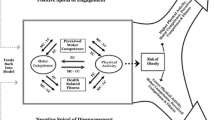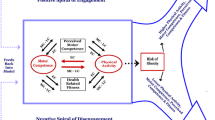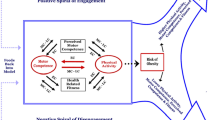Abstract
Background
Motor competence and physical fitness are important factors for promoting positive trajectories of health over time. In 2008, Stodden and colleagues developed a model that discussed the role of both factors in physical activity. Furthermore, the authors hypothesized that the relationship between motor competence and physical fitness is reciprocal and changes over time.
Objective
The aim of the present meta-analysis was to synthesize the evidence on the relationship between motor competence and components of physical fitness from early childhood to early adulthood and the potential influence of age.
Methods
Scientific databases Web of Science and PubMed were used for the literature search. German- as well as English-language studies were included that assessed typically developing children. In accordance with the PRISMA guidelines, 93 studies between 2005 and June 2018 were screened in full. Nineteen studies comprising of 32 samples, 87 single data points from 15,984 participants aged 4.5–20.4 years (Mage = 11.44, SD = 4.77) were included in the analysis.
Results
A random effects model was conducted for the meta-regression with age as moderator variable. The relationship between motor competence and physical fitness was moderate to large (r = 0.43, p < 0.001) after controlling for multiple effects, including dependent samples and small sample sizes in the quantitative synthesis. Additionally, age was a small significant positive moderator of the effect size.
Conclusions and Implications
The findings provide support for a moderate to large positive relationship between motor competence and physical fitness that strengthens with increasing age. However, the results also indicate that there may be an overlap in content between motor competence and physical fitness assessments, which warrants further investigation. More research is also needed to assess similarities and differences in terms of the construct structures.



Similar content being viewed by others
References
WHO. Facts and figures on childhood obesity. 2014. http://www.who.int/end-childhood-obesity/facts/en. Accessed 9 June 2017.
WHO. Ending Childhood Obesity. 2016. http://apps.who.int/iris/bitstream/10665/204176/1/9789241510066_eng.pdf?ua=1. Accessed 9 June 2017.
WHO. Physical Activity. 2017. http://www.who.int/mediacentre/factsheets/fs385/en/. Accessed 9 June 2017.
Stodden DFF, Goodway JDD, Langendorfer SJJ, Roberton MAA, Rudisill MEE, Garcia C, et al. A developmental perspective on the role of motor skill competence in physical activity: An emergent relationship. Quest. 2008;60:290–306.
Robinson LE, Stodden DF, Barnett LM, Lopes VP, Logan SW, Rodrigues LP, et al. Motor competence and its effect on positive developmental trajectories of health. Sport Med. 2015;45:1273–84.
Utesch T, Bardid F, Huyben F, Strauss B, Tietjens M, De Martelaer K, et al. Using Rasch modeling to investigate the construct of motor competence in early childhood. Psychol Sport Exerc. 2016;24:179–87.
Utesch T, Bardid F. Motor competence. In: Hackfort D, Schinke R, Strauss B, editors. Dictionary of sport psychology. Amsterdam: Elsevier; 2019.
Bardid F, Utesch T, Lenoir M. Investigating the construct of motor competence in middle childhood. J Sport Exerc Psychol. 2017;39:51–2.
Logan SW, Webster EK, Getchell N, Pfeiffer KA, Robinson LE. Relationship between fundamental motor skill competence and physical activity during childhood and adolescence: a systematic review. Kinesiol Rev. 2015;4:416–26.
Holfelder B, Schott N. Relationship of fundamental movement skills and physical activity in children and adolescents: a systematic review. Psychol Sport Exerc. 2014;15:382–91.
Lubans DR, Morgan PJ, Cliff DP, Barnett LM, Okely AD. Fundamental movement skills in children and adolescents: review of associated health benefits. Sport Med. 2010;40:1019–35.
Utesch T, Dreiskämper D, Naul R, Geukes K. Understanding physical (in-) activity, overweight, and obesity in childhood: effects of congruence between physical self-concept and motor competence. Sci Rep. 2018;8:5908.
Barnett LM, Van Beurden E, Morgan PJ, Brooks LO, Beard JR. Does childhood motor skill proficiency predict adolescent fitness? Med Sci Sports Exerc. 2008;40:2137–44.
Lopes VP, Rodrigues LP, Maia JAR, Malina RM. Motor coordination as predictor of physical activity in childhood. Scand J Med Sci Sport. 2011;21:663–9.
Ortega FB, Ruiz JR, Castillo MJ, Sjöström M. Physical fitness in childhood and adolescence: a powerful marker of health. Int J Obes. Nature Publishing Group. 2008;32:1–11.
Utesch T, Dreiskämper D, Strauss B, Naul R. The development of the physical fitness construct across childhood. Scand J Med Sci Sport. 2017;28(1):212–9.
Utesch T, Zinner J, Büsch D. Stabilität der physischen fitness im kindesalter. Ger J Exerc Sport Res. 2018;48(3):404–14.
Janssen I, LeBlanc AG. Systematic review of the health benefits of physical activity and fitness in school-aged children and youth. Int J Behav Nutr Phys Act. 2010;7:40.
Khodaverdi Z, Bahram A, Stodden D, Kazemnejad A. The relationship between actual motor competence and physical activity in children: mediating roles of perceived motor competence and health-related physical fitness. J Sports Sci. 2016;34:1523–9.
Cattuzzo MT, dos Santos Henrique R, Ré AHN, de Oliveira IS, Melo BM, de Sousa Moura M, et al. Motor competence and health related physical fitness in youth: a systematic review. J Sci Med Sport. 2015;19:123–9.
Maxwell SE, Kelley K, Rausch JR. Sample size planning for statistical power and accuracy in parameter estimation. Annu Rev Psychol. 2008;59:537–63.
Stodden DF, Goodway JD, Langendorfer SJ. Dynamic relationships between motor skill competence and health-related fitness in youth. Pediatr Exerc Sci. 2014;26:231–41.
Stodden D, Langendorfer S, Roberton MA. The association between motor skill competence and physical fitness in young adults. Res Q Exerc Sport. 2009;80:223–9.
Burton AW, Rodgerson RW. New perspectives on the assessment of movement skills and motor abilities. Adapt Phys Act Q. 2001;18:347–65.
Moher D, Liberati A, Tetzlaff J, Altman DG. Preferred Reporting items for systematic reviews and meta-analyses: the PRISMA statement. PLoS Med. 2009;6:e1000097.
Haga M. The relationship between physical fitness and motor competence in children. Child Care Health Dev. 2008;34:329–34.
Burton AW, Miller DE. Movement skill assessment. Champaign: Human Kinetics; 1998.
Gallahue DL, Ozmun JC, Goodway JD. Understanding motor development: infants, children, adolescents, adults. 7th ed. New York: McGraw-Hill; 2012.
Rudd J, Butson ML, Barnett L, Farrow D, Berry J, Borkoles E, et al. A holistic measurement model of movement competency in children. J Sports Sci. 2016;34:477–85.
da Luz CMN, de Almeida GSN, Rodrigues LP, Cordovil R, da Luz CMN, de Almeida GSN, et al. The evaluation of motor competence in typically developing children: an integrative review. J Phys Educ. 2017;28:e2857.
Caspersen CJ, Christenson GM. Physical activity, exercise, and physical fitness: definitions and distinctions for health-related research. Public Health Rep. 1985;100:126–31.
Burns R, Brusseau T, Hannon J. Multivariate associations among health-related fitness, physical activity, and TGMD-3 test items in disadvantaged children from low-income families. Percept Mot Skills. 2017;124:86–104.
Castelli DM, Valley JA. The relationship of physical fitness and motor competence to physical activity. J Teach Phys Educ. 2007;26:358–74.
Gu X, Thomas K, Chen Y-L. The role of perceived and actual motor competency on children’s physical activity and cardiorespiratory fitness during middle childhood. J Teach Phys Educ. 2017;36:388–97.
Hands B, Larkin D, Parker H, Straker L, Perry M. The relationship among physical activity, motor competence and health-related fitness in 14-year-old adolescents. Scand J Med Sci Sport. 2009;19:655–63.
Hardy LL, Reinten-Reynolds T, Espinel P, Zask A, Okely AD. Prevalence and correlates of low fundamental movement skill competency in children. Pediatrics. 2012;130:e390–8.
Lima RA, Pfeiffer KA, Bugge A, Moller NC, Andersen LB, Stodden DF. Motor competence and cardiorespiratory fitness have greater influence on body fatness than physical activity across time. Scand J Med Sci Sports. 2017;27:1638–47.
Oberer N, Gashaj V, Roebers CM. Executive functions, visual-motor coordination, physical fitness and academic achievement: longitudinal relations in typically developing children. Hum Mov Sci. 2018;58:69–79.
Pereira SA, Seabra AT, Silva RG, Zhu W, Beunen GP, Maia JA. Correlates of health-related physical fitness levels of Portuguese children. Int J Pediatr Obes. 2011;6:53–9.
Tveter AT, Holm I. Influence of thigh muscle strength and balance on hop length in one-legged hopping in children aged 7–12 years. Gait Posture. England. 2010;32:259–62.
Vandendriessche JB, Vandorpe B, Coelho-e-Silva MJ, Vaeyens R, Lenoir M, Lefevre J, et al. Multivariate association among morphology, fitness, and motor coordination characteristics in boys age 7 to 11. Pediatr Exerc Sci. United States. 2011;23:504–20.
Vedul-Kjelsås V, Sigmundsson H, Stensdotter a. K, Haga M. The relationship between motor competence, physical fitness and self-perception in children. Child Care Health Dev. 2012;38:394–402.
Vlahov E, Baghurst TM, Mwavita M. Preschool motor development predicting high school health-related physical fitness: a prospective study. Percept Mot Skills. 2014;119:279–91.
Ré AHN, Cattuzzo MT, Henrique R dos S, Stodden DF. Physical characteristics that predict involvement with the ball in recreational youth soccer. J Sports Sci. 2016;34:1716–22.
Jaakkola T, Yli-Piipari S, Huotari P, Watt A, Liukkonen J. Fundamental movement skills and physical fitness as predictors of physical activity: a 6-year follow-up study. Scand J Med Sci Sports. 2016;26:74–81.
Hedges LV, Tipton E, Johnson MC. Robust variance estimation in meta-regression with dependent effect size estimates. 2010;1:39–65.
Tipton E. Small sample adjustments for robust variance estimation with meta-regression. Psychol Methods. 2015;20:375–93.
Cohen J. Statistical power analysis for the behavioral sciences. 2nd ed. New Jersey: Lawrence Erlbaum Associates, Inc; 1988.
Lenhard W, Lenhard A. Calculation of effect sizes [Internet]. Dettelbach; 2016. https://www.psychometrica.de/effect_size.html. Accessed 20 Feb 2018.
Carter EC, Hilgard J, Schönbrodt FD, Gervais WM. Correcting for bias in psychology: a comparison of meta-analytic methods. OSF pre-print. 2017; https://osf.io/rf3ys/. Accessed 20 Jan 2018.
R Core Team. R: a language and environment for statistical computing [Statistical Software]. Vienna: R Foundation for Statistical Computing; 2017.
Viechtbauer W. Conducting meta-analyses in R with the metafor package. J Stat Softw. 2010;36:1–48.
Fisher Z, Tipton E. Robumeta: Robust variance meta-regression. R package version 1.6. 2015.
Bardid F, Huyben F, Deconinck FJ, De Martelaer K, Seghers J, Lenoir M. Convergent and divergent validity between the KTK and MOT 4-6 motor tests in early childhood. Adapt Phys Act Q. 2016;33:33–47.
Fransen J, D’Hondt E, Bourgois J, Vaeyens R, Philippaerts RMM, Lenoir M, et al. Motor competence assessment in children: convergent and discriminant validity between the BOT-2 Short Form and KTK testing batteries. Res Dev Disabil. Elsevier Ltd. 2014;35:1375–83.
Kiphard EJ, Schilling F. Körperkoordinationstest für Kinder [Body Coordination Test]. Weinheim: Beltz Test; 1974.
Kiphard EJ, Schilling F. Körperkoordinationstest für Kinder [Body Coordination Test]. Weinheim: Beltz Test GmbH; 2007.
Henderson SE, Sugden DA, Barnett A. Movement assessment battery for children. 2nd ed. London: Harcourt Assessment; 2007.
Sacko RS, McIver K, Brian A, Stodden DF. New insight for activity intensity relativity, metabolic expenditure during object projection skill performance. J Sports Sci. 2018;36:2412–8.
Haywood KM, Getchell N. Life span motor development. 6th ed. Champaign: Human Kinetics; 2014.
Bardid F, Vannozzi G, Logan SW, Hardy LL, Barnett LM. A hitchhiker’s guide to assessing young people’s motor competence: deciding what method to use. J Sci Med Sport. 2018;22(3):311–8.
Barnett LM, Lai SK, Veldman SLC, Hardy LL, Cliff DP. Correlates of gross motor competence in children and adolescents: a systematic review and meta-analysis. Sport Med [Internet]. 2016;46(11):1663–88.
Blum D, Holling H. Spearman’s law of diminishing returns. A meta-analysis. Intelligence. 2017;65:60–6.
Acknowledgements
We would like to thank Jan Beck and David Niehues for their help in the data screening process.
Author information
Authors and Affiliations
Contributions
Dr. Till Utesch conceptualized the study, coordinated and supervised data collection, carried out the data analyses, drafted and revised the manuscript, and approved the final manuscript as submitted. Dr. Farid Bardid conceptualized the study, contributed to drafting and revising the manuscript, and approved the final manuscript as submitted. Prof. Dr. Dirk Büsch critically conceptualized the study, critically reviewed the manuscript, and approved the final manuscript as submitted. Prof. Dr. Bernd Strauss conceptualized the study, critically reviewed the manuscript, and approved the final manuscript as submitted.
Corresponding author
Ethics declarations
Data Availability Statement
The data that support the findings of this study are available on the Open Science Framework (OSF) (http://doi.org/10.17605/OSF.IO/P36RQ or https://osf.io/p36rq). This includes the final data file and R script used to conduct the meta-analysis, and the BibTex files that cover all records retrieved from the literature search.
Competing interests
The authors declare that they have no competing interests.
Funding
No financial support was received for the conduct of this review or preparation of this manuscript.
Rights and permissions
About this article
Cite this article
Utesch, T., Bardid, F., Büsch, D. et al. The Relationship Between Motor Competence and Physical Fitness from Early Childhood to Early Adulthood: A Meta-Analysis. Sports Med 49, 541–551 (2019). https://doi.org/10.1007/s40279-019-01068-y
Published:
Issue Date:
DOI: https://doi.org/10.1007/s40279-019-01068-y




